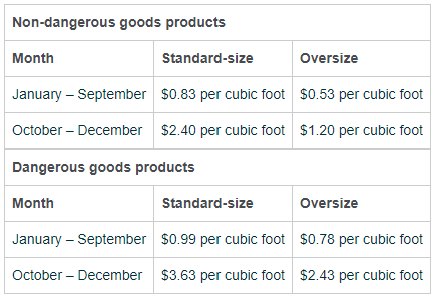
Updated April 19, 2022.
Amazon Prime continues to climb in popularity with customers, thanks to its free and super-fast delivery perks. On the seller side of Amazon Prime is “Fulfilled by Amazon (FBA)”, which allows participating sellers to get the coveted Prime badge on their product listings. It also provides them with outsourced customer service, storage, fulfillment, and shipping, all of which Amazon handles on their behalf. But the benefits of FBA come with a cost, known as storage fees.
Amazon operates more than 175 fulfillment centers worldwide with more than 150 million square feet of space. While this may seem like a lot of storage room, remember – there are 9.5 million Amazon sellers globally, and 73% of those sellers use the FBA service!
Therefore, Amazon only has a set amount of space to store their FBA sellers’ goods, so they have to charge storage fees. These fees are meant to motivate sellers to move inventory quickly and be penalized for what lags behind.
There are different types of FBA storage fees – long-term and short-term. To review your prior history of storage fees, you can access a Long Term Storage Fee Report.
How Amazon Calculates FBA Storage Fees
Amazon uses a FIFO (first in, first out) accounting method to calculate FBA storage fees. FIFO means that items sold or removed are deducted from the inventory that has been stored the longest, regardless of which unit was actually shipped or removed.
FBA Monthly Storage Fees
Amazon charges monthly inventory storage fees for the space your products take up in their fulfillment centers. They calculate storage fees based on your daily average volume in cubic feet. These fees then vary based on product size – standard-size or over-size – and time of year.
If your products fall under the dangerous goods category, your storage fees will be higher.
Amazon charges monthly inventory storage fees between the 7th and 15th day of the month following the month for which the fee is applicable. For example, to view your inventory storage fee for February, look at your March Payments report transactions from March 7-15.

It’s important to mention that although standard-size products are physically smaller than oversize, they demand a more expensive storage situation. The need for costly shelving, drawers, and bins is what drives the fee upwards (seen in the graph above).
Long-Term Storage Fees
If your inventory has been sitting in a fulfillment center for more than 365 days, you’ll incur a long-term storage fee. The storage fee will be $6.90/mo per cubic foot, or $0.15/unit, whichever is greater.
If you remove a product that is subject to long-term storage fees at the next inventory cleanup date, Amazon will not allow you to send in any more units of that product for the following three months after the removal date.

Ways to Reduce Your Storage Fees
The more your product sales are lagging, the slower you’ll move your inventory. The slower you move your inventory, the more you’ll pay in Amazon FBA storage fees. The good news is there are strategies to help you avoid paying excessive storage fees.
- Ship your Inventory Back: If you voluntarily remove your inventory from an FBA warehouse, it will stop your long-term storage fees from racking up. To do this, submit a removal order. You can also remove inventory automatically when specific criteria are met. Hot tip: check out the fees for removing or disposing inventory here.
- Discount Product Pricing: Selling your products at a discount can be a cost-effective way to move inventory and reduce your storage fees. It may even make more sense to sell your products at a loss. This is because long-term storage fees can add up quickly and could hurt your bottom line more than the loss of profits from your product sales.
- Run Amazon Ads and Promotions: Another good way to avoid long-term storage fees is to run a product promotion or PPC ad campaign. If the ads cost less than the storage fees and help increase your product, then it’s a money-saving strategy to use.
- Inventory Timing and Management: When ordering large inventory quantities, it’s best to send your inventory to Amazon in smaller batches. Roll out your FBA inventory shipments on a timeline that matches the product’s sales. Knowing how long it takes to cycle through your inventory will tell you how much stock you can afford to send in at a time and mitigate your storage costs. Ideally, you only want to have 30-45 days’ worth of inventory in FBA storage at any given time.
Identify Inventory at Risk for Long-Term Storage Fees
You can access your Manage Inventory Health Report to review data that helps you manage your inventory more effectively. This report provides the following metrics for making the best decisions:
- Estimated monthly and long-term storage fees on your next charge date
- Seven-day, 30-day, 60-day, and 90-day sales and units shipped
- Days of supply
- Excess units
- Your list prices
- Recommended actions for aged and excess inventory
- Shipment quantities: working, shipped, and receiving
You can also use your Manage Inventory Health Report to identify your overstock inventory. This allows you to act sooner rather than later and help curb your FBA long-term storage spending.
About Channeled
Channeled is a full-service agency. We combine strategy and execution to deliver full channel management for multi-channel, direct-to-consumer brands that sell on Amazon and beyond.
From strategy to brand management and advertising to logistics, we are a trusted partner for scaling DTC brands. Contact us to learn more about our suite of services.
